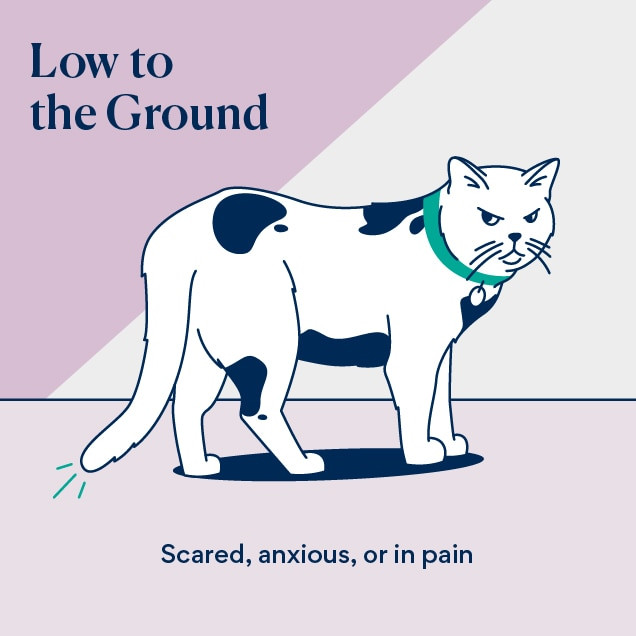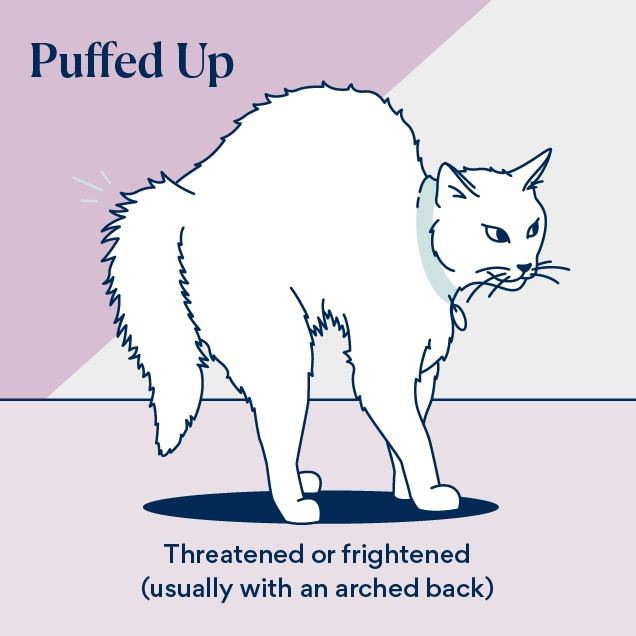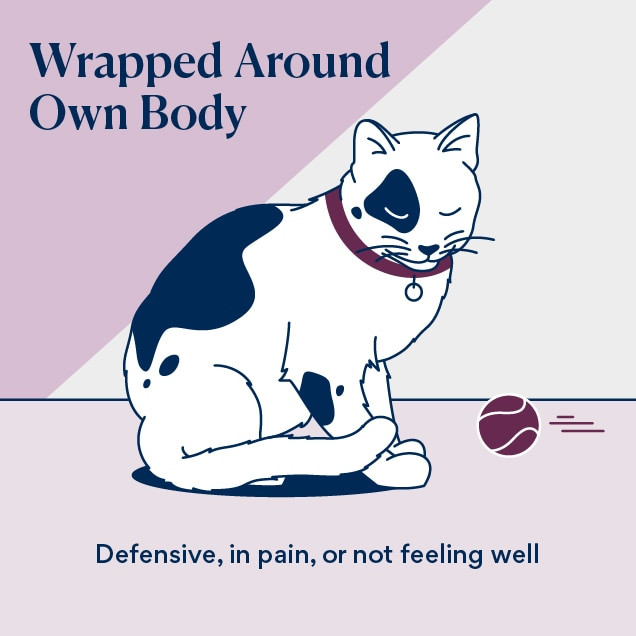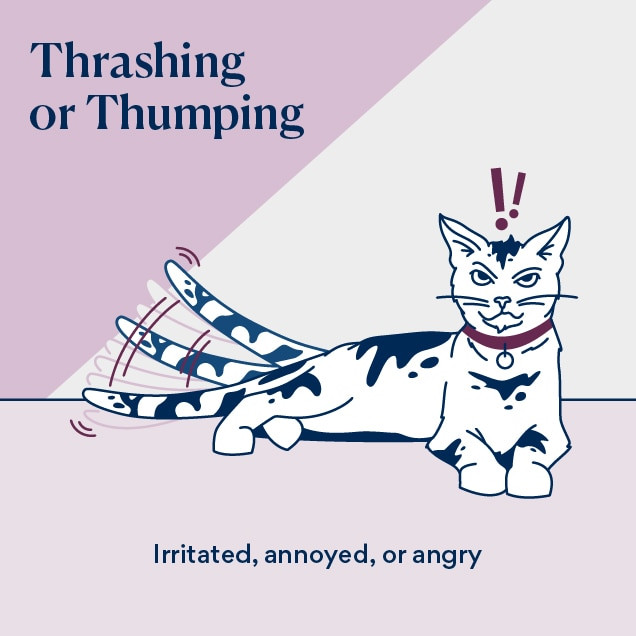What Does It Mean When Cats Flick Their Tails? At solcat.net, we unravel the mysteries of feline behavior, starting with their expressive tails. Understanding these movements can lead to a deeper connection with your feline friend. By learning to interpret the subtle language of your cat’s tail, you’ll gain valuable insights into their mood, intentions, and overall well-being.
1. The Importance of Understanding Cat Tail Language
Decoding your cat’s tail language is essential for a harmonious relationship. By understanding what different tail movements mean, you can better respond to your cat’s needs and create a more comfortable and enriching environment. Understanding cat tail language will help you to better understand your cat.
- Improved Communication: Tail movements are a vital part of feline communication, helping you understand their emotions and intentions.
- Stronger Bond: Recognizing and responding to your cat’s signals strengthens your bond and builds trust.
- Early Problem Detection: Changes in tail behavior can indicate underlying health issues or stress, allowing for early intervention.
1.1. Enhancing Communication and Bonding
Understanding your cat’s tail language is similar to learning a new language. It enables you to “hear” what your cat is trying to say, even when they’re not meowing or purring. This deeper understanding fosters a stronger bond and a more fulfilling relationship.
1.2. Identifying Potential Health Concerns
A sudden change in your cat’s tail behavior can be a sign of an underlying health issue. For example, a cat who normally holds their tail high might start tucking it between their legs if they’re in pain or feeling unwell. By being aware of these changes, you can seek veterinary care early and address any potential problems.
2. Decoding Common Cat Tail Positions
The position of your cat’s tail can tell you a lot about how they’re feeling. From upright and confident to low and fearful, each position conveys a specific message.
2.1. Tail Straight Up: Confidence and Friendliness
A tail held straight up indicates that your cat is feeling confident, social, and friendly. They are approaching you or another cat in a positive and welcoming manner.
- Friendly Greeting: This is a common greeting between cats, signaling a willingness to interact.
- Invitation for Interaction: A cat with its tail up is open to being petted, played with, or simply spending time with you.
- Kitten Behavior: Kittens often greet their mothers with their tails held high, demonstrating trust and affection.
According to research from the University of Southampton, cats readily approach a cat-shaped silhouette with a raised tail, indicating its positive association.
2.2. Tail as a Question Mark or Hook: Playfulness and Invitation
When your cat’s tail forms a question mark shape, with an upright position and a curl at the end, it indicates happiness and an invitation to interact.
- Playful Mood: This tail position often signals that your cat is in a playful mood and looking for attention.
- Gentle Interaction: While you might be tempted to pet the tail itself, most cats prefer being petted around their facial glands.
- Positive Engagement: This tail posture is a great sign that your cat is enjoying your company.
2.3. Tail Held Low to the Ground: Fear or Anxiety
 Cat with tail held low to the ground
Cat with tail held low to the ground
A cat holding their tail low to the ground, below the level of their back, is likely feeling frightened or anxious.
- Submissive Posture: This position can also indicate submission or discomfort in a social situation.
- Potential Threat: The cat may perceive a threat in their environment, causing them to lower their tail as a protective measure.
- Extreme Fear: If the tail is tucked tightly between the legs, the cat is experiencing intense fear or possibly pain.
2.4. Tail Puffed Up: Fear and Defense
 Cat with a puffed-up tail
Cat with a puffed-up tail
A puffed-up tail, often accompanied by an arched back, is a classic sign of fear and defensiveness in cats.
- Halloween Cat Posture: This posture is a defensive reaction to a sudden, severe threat.
- Piloerection: The hair stands on end to make the cat appear larger and more intimidating.
- Avoid Interaction: It’s best to avoid interacting with a cat in this state, as they may perceive your approach as a threat.
2.5. Tail Wrapped Around the Body: Fear, Pain, or Illness
 Cat with tail wrapped around their body
Cat with tail wrapped around their body
When a cat is sitting or lying down with their tail wrapped tightly around their body, they may be feeling frightened, defensive, in pain, or unwell.
- Protective Posture: This position is a way for the cat to protect themselves and minimize vulnerability.
- Discomfort: It can also indicate physical discomfort or illness.
- Veterinary Evaluation: If this behavior persists for more than a few days, a veterinary evaluation is recommended.
3. Understanding Tail Wagging in Cats
Unlike dogs, cats don’t typically wag their tails to express happiness. Instead, tail wagging in cats often indicates irritation, frustration, or conflict.
3.1. Thrashing Tail Movements: Irritation and Anger
 Cat thrashing their tail
Cat thrashing their tail
When a cat thrashes their tail or thumps it on the ground, they are usually feeling irritated, annoyed, or angry.
- Distance-Increasing Behavior: This behavior is a clear signal that the cat wants to be left alone.
- Potential Aggression: If you continue to interact with a cat who is thrashing their tail, they may hiss, growl, swat, or bite.
- Respect Boundaries: It’s important to respect the cat’s boundaries and give them space when they exhibit this behavior.
3.2. Twitching Tail End: Mixed Emotions
A twitching tail end can indicate a variety of emotions, including hunting, playing, mild irritation, or frustration.
- Context Matters: The meaning of a twitching tail depends on the context and other body language cues.
- Hunting Mode: If the cat is focused on a toy or something outside, they may be in hunting mode.
- Annoyance: If they are not playing or stalking, the twitching tail likely indicates annoyance.
3.3. Swishing Tails: Focus and Predatory Behavior
When a cat slowly swishes their tail from side to side, they are often intently focused on something, such as a toy, another animal, or something outside.
- Predatory Instincts: This behavior is often a prelude to pouncing or engaging in other predatory behaviors.
- Enrichment: Allowing your cat to engage in these behaviors provides important enrichment and mental stimulation.
- Observation: The cat may be observing its target, gathering information before attacking.
3.4. Tail Quivers: Excitement or Urine Marking
A quivering tail can indicate excitement, especially when greeting you or another cat. However, it can also be a sign of urine marking.
- Excited Greeting: When a cat quivers their tail while approaching you, it’s a sign of excitement and affection.
- Urine Marking: If the cat is holding their tail straight up and backing up against a vertical surface while quivering, they may be urine marking.
- Territorial Behavior: Urine marking is a way for cats to mark their territory and communicate with other cats.
4. Tail Wrapping: Affection and Social Bonding
Cats may wrap their tails around people or other cats as a sign of affection and social bonding.
4.1. Affiliative Behavior
Tail wrapping is an affiliative behavior, indicating a willingness to interact and form a bond.
- Greeting Behavior: Similar to handshakes or hugs in humans, tail wrapping is a way for cats to greet each other and express friendliness.
- Comfort and Security: Cats may also wrap their tails around people or other cats for comfort and security.
- Social Connection: This behavior demonstrates a desire for social connection and closeness.
5. Integrating Tail Language with Other Body Language Cues
While tail movements are important, it’s essential to consider other body language cues to fully understand your cat’s emotional state.
5.1. Eyes, Ears, and Body Posture
Pay attention to your cat’s eyes, ears, and overall body posture to get a complete picture of their mood and intentions.
- Eyes: Dilated pupils can indicate fear or excitement, while narrowed eyes can indicate aggression or irritation.
- Ears: Ears that are forward and alert indicate interest, while ears that are flattened or turned to the side indicate fear or aggression.
- Body Posture: A relaxed body posture indicates comfort, while a tense or crouched posture indicates fear or anxiety.
5.2. Vocalizations
Combine your understanding of tail language with your cat’s vocalizations, such as meows, purrs, hisses, and growls, for a more complete understanding of their communication.
- Meows: Meows can indicate a variety of needs, such as hunger, attention, or a desire to go outside.
- Purrs: Purring usually indicates contentment, but it can also be a sign of self-soothing when a cat is in pain or stressed.
- Hisses and Growls: Hisses and growls are clear warning signs that a cat is feeling threatened or aggressive.
5.3. Facial Expressions
Observe your cat’s facial expressions, including their whiskers, mouth, and brow, to further understand their emotions.
- Whiskers: Whiskers that are relaxed and forward indicate curiosity, while whiskers that are flattened against the face indicate fear or anxiety.
- Mouth: A relaxed mouth indicates comfort, while a tense or open mouth can indicate fear or aggression.
- Brow: A furrowed brow can indicate stress or discomfort.
6. Understanding the Nuances of “Flicking”
What does it mean when cats flick their tails? The speed and intensity of the flick, as well as the overall context, are key to understanding the message.
6.1. Subtle Tail Flick: Mild Irritation or Focus
A gentle, subtle flick of the tail often signals mild irritation or heightened focus. Your cat may be slightly annoyed by something in their environment or deeply concentrated on a nearby object or sound.
- Observational Cues: Look for other signs of focus such as dilated pupils, perked ears, and a still body. If the flick is accompanied by flattened ears or a low growl, it’s more likely a sign of irritation.
- Contextual Clues: Consider what’s happening around your cat. Is there a new object in their space, a loud noise, or are they being disturbed while resting?
6.2. Rapid Tail Flick: High Alert or Agitation
A rapid, side-to-side flick of the tail indicates heightened alertness, agitation, or potential aggression. Your cat is experiencing a strong emotional response and is on high alert.
- Body Language: Watch for other signs of agitation, such as tense muscles, dilated pupils, a low body posture, or hissing.
- Environmental Assessment: Identify potential stressors in your cat’s environment and remove them if possible. Give your cat space and avoid direct interaction until they have calmed down.
- Respect Boundaries: It’s crucial to recognize and respect your cat’s boundaries when they display this behavior to prevent escalation into aggression.
6.3. Tail Twitch at the Tip: Playfulness or Curiosity
A slight twitch at the very tip of the tail often indicates playfulness, curiosity, or anticipation. Your cat is engaged and interested in their surroundings.
- Engagement Indicators: Look for signs of playfulness, such as stalking, pouncing, or batting at objects. The twitch may intensify as your cat prepares to engage in active play.
- Interactive Play: Engage your cat with toys or activities that stimulate their hunting instincts to provide a healthy outlet for their energy.
- Positive Reinforcement: Reward playful behavior with praise and affection to reinforce positive interactions.
6.4. Combining Flicking with Other Tail Positions
The meaning of a flick can also depend on the overall position of the tail. A flick combined with a high, upright tail might indicate playful excitement, while a flick combined with a low, tucked tail could signal fear or uncertainty.
7. Factors Influencing Tail Language
Several factors can influence a cat’s tail language, including their age, breed, personality, and environment.
7.1. Age and Experience
Kittens may not have fully developed their communication skills, while older cats may exhibit different tail behaviors due to age-related changes or health conditions.
- Kitten Development: Kittens are still learning to control their movements and may not always be able to accurately convey their intentions.
- Senior Cats: Senior cats may have reduced mobility or sensory impairments, which can affect their tail language.
- Life Experiences: A cat’s past experiences can also influence their tail behaviors, especially if they have experienced trauma or abuse.
7.2. Breed and Genetics
Some cat breeds are known for being more vocal or expressive than others, which can also affect their tail language.
- Vocal Breeds: Breeds like Siamese and Burmese are known for their vocalizations, which can complement their tail language.
- Quiet Breeds: Breeds like Persians and Ragdolls tend to be quieter and may rely more on subtle tail movements to communicate.
- Genetic Predisposition: Genetics can also play a role in a cat’s personality and communication style.
7.3. Personality and Temperament
Each cat has a unique personality and temperament, which can influence their tail language.
- Confident Cats: Confident cats tend to hold their tails high and exhibit more assertive tail movements.
- Shy Cats: Shy cats may be more reserved and exhibit more subtle tail behaviors.
- Individual Differences: It’s important to get to know your cat’s individual personality and learn how they express themselves through their tail language.
7.4. Environment and Social Interactions
A cat’s environment and social interactions can also affect their tail language.
- Stressful Environments: A stressful environment can cause a cat to exhibit more fearful or defensive tail behaviors.
- Social Interactions: A cat’s interactions with other cats and people can also influence their tail language.
- Safe and Secure: Providing a safe and secure environment can help a cat feel more confident and relaxed, which can positively affect their tail language.
8. Common Misinterpretations of Cat Tail Language
It’s important to avoid common misinterpretations of cat tail language to ensure you’re accurately understanding your feline friend.
8.1. Wagging Tail = Happiness
Unlike dogs, cats don’t typically wag their tails to express happiness. A wagging tail in cats usually indicates irritation, frustration, or conflict.
- Context is Key: Pay attention to other body language cues and the context of the situation to determine the meaning of a wagging tail.
- Avoid Assumptions: Don’t assume that a wagging tail means the cat is happy or friendly.
- Respect Boundaries: If a cat is wagging their tail and exhibiting other signs of irritation, give them space and avoid interacting with them.
8.2. Still Tail = Neutral Emotion
A still tail doesn’t necessarily mean that a cat is feeling neutral. It can also indicate focus, observation, or even fear.
- Observe Carefully: Pay attention to the cat’s other body language cues and the environment to determine what they’re feeling.
- Consider the Context: A still tail can have different meanings depending on the situation.
- Avoid Assumptions: Don’t assume that a still tail means the cat is feeling nothing at all.
8.3. Ignoring Other Body Language Cues
Relying solely on tail language without considering other body language cues can lead to misinterpretations.
- Holistic Approach: Take a holistic approach to understanding your cat’s communication by considering all of their body language cues.
- Observe Carefully: Pay attention to their eyes, ears, body posture, vocalizations, and facial expressions.
- Accurate Interpretation: By considering all of these cues together, you can more accurately interpret your cat’s emotional state.
9. Resources for Learning More About Cat Behavior
There are many resources available to help you learn more about cat behavior and communication.
9.1. Books and Articles
Numerous books and articles have been written about cat behavior, providing valuable insights and practical tips.
- “The Cat Whisperer” by Mieshelle Nagelschneider: This book offers practical advice on understanding and resolving common cat behavior problems.
- “Decoding Your Cat” by the American College of Veterinary Behaviorists: This book provides a comprehensive overview of cat behavior and communication.
- Online Articles: Websites like solcat.net offer a wealth of information on cat behavior, health, and care.
9.2. Veterinarians and Behaviorists
Veterinarians and certified animal behaviorists can provide expert guidance on understanding and addressing cat behavior issues.
- Veterinary Checkups: Regular veterinary checkups are important for identifying and addressing any underlying health conditions that may be affecting your cat’s behavior.
- Behavior Consultations: A certified animal behaviorist can help you understand your cat’s behavior and develop a customized treatment plan.
- Professional Advice: Don’t hesitate to seek professional advice if you’re struggling to understand or manage your cat’s behavior.
9.3. Online Communities and Forums
Online communities and forums can provide a supportive environment for sharing information and experiences with other cat owners.
- Social Media Groups: Join social media groups dedicated to cat behavior and communication.
- Online Forums: Participate in online forums where you can ask questions and share your experiences with other cat owners.
- Community Support: These communities can provide valuable support and encouragement as you learn more about your cat’s behavior.
10. Responding Appropriately to Your Cat’s Tail Language
By understanding your cat’s tail language, you can respond appropriately to their needs and create a more harmonious relationship.
10.1. Providing a Safe and Secure Environment
Ensure that your cat has a safe and secure environment where they feel comfortable and relaxed.
- Minimize Stressors: Identify and minimize any stressors in your cat’s environment, such as loud noises, unfamiliar people, or aggressive animals.
- Provide Resources: Provide your cat with plenty of resources, such as food, water, litter boxes, scratching posts, and toys.
- Create a Sanctuary: Create a quiet and comfortable space where your cat can retreat when they feel overwhelmed.
10.2. Respecting Boundaries
Respect your cat’s boundaries and avoid forcing interactions when they are feeling fearful, anxious, or irritated.
- Recognize Signals: Learn to recognize the signals that indicate your cat wants to be left alone, such as a thrashing tail, flattened ears, or a tense body posture.
- Give Space: Give your cat space when they exhibit these behaviors and avoid approaching them until they have calmed down.
- Avoid Punishment: Never punish your cat for their behavior, as this can damage your relationship and make the problem worse.
10.3. Positive Reinforcement
Use positive reinforcement techniques, such as praise, treats, and play, to encourage desired behaviors.
- Reward Good Behavior: Reward your cat when they exhibit desirable behaviors, such as using the litter box, playing gently, or greeting you calmly.
- Avoid Negative Reinforcement: Avoid using negative reinforcement techniques, such as yelling or hitting, as this can create fear and anxiety.
- Build Trust: Positive reinforcement can help you build trust with your cat and strengthen your bond.
10.4. Seeking Professional Help
Address: 950 Alaskan Way, Seattle, WA 98104, United States. Phone: +1 (206) 386-4000. Website: solcat.net.
When you know “what does it mean when cats flick their tails,” you unlock a deeper understanding of your feline companion. At solcat.net, we’re passionate about providing you with the resources and knowledge you need to create a thriving relationship with your cat.
Ready to dive deeper into the world of cat behavior? Visit solcat.net today and explore our extensive collection of articles, images, and videos. Whether you’re a seasoned cat owner or just starting your feline journey, solcat.net is your trusted source for all things cat-related. Connect with our vibrant community of cat lovers, ask questions, and share your experiences. Together, we can create a world where every cat is understood, cherished, and thrives.
